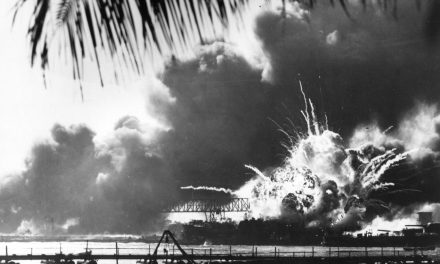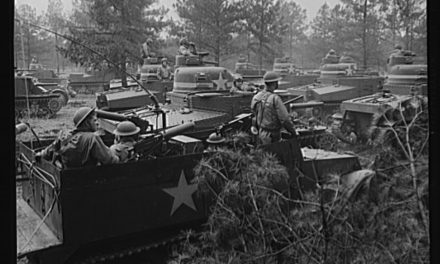William G. Roy, a flight deck motion picture cameraman aboard the aircraft carrier U.S.S. Yorktown, held the important position of filming every aircraft landing with his with his 35-millimeter camera. His job is crucial to improving aircraft landing techniques: if something goes wrong, it’s on film and can be analyzed later. Roy has filmed more than a dozen air deck crashes, but nothing compares to what he would attempt to capture during the Battle of Midway. “We were stopped dead in the water. We were burning and smoking,” said Roy.
As the Yorktown sailed from Pearl Harbor on June 4, the crew prepared for attack. It was early afternoon, Roy recalls, when torpedoes suddenly began coming from different directions. Anywhere the ship tried to turn, it faced a torpedo. At this time, Roy was on the signal bridge of the ship. He loved the visibility and exposure that area of the ship provided for his photographs, but after realizing a torpedo had hit nearby, he had to abandon the signal bridge. As Roy tried to make his way to safety, more torpedoes came in. “They were coming right at me,” he said. As he ran with his camera away from the bombing to the other side of the ship, he felt explosion after explosion. The last bomb, however, was what shook the ship the most. “That time it shook the ship like a wet cloth,” said Roy.

The U.S.S. Yorktown, the aircraft carrier on which William G. Roy served, shown in 1937. From National Archives.
Throughout the chaos Roy took several pictures, including one of a ship cut in half after being struck. He captured the scene from afar as the ship broke in two; three of those images have been published thus far. He witnessed a boat swain of the minesweeper Viero, which was tied to U.S.S Yorktown at the time, trying to cut its tow cables. Just as he snapped a photo, the man blew up right in front of him. That picture, which left Roy deeply shaken, is unlikely to be published.
That afternoon, a severely damaged Yorktown tried to head to port. The air deck was almost in the water and there was a fear it may roll over and sink. The ship had lost power and had no pumps, causing it to be dead in the water. After an inspection by a damage control officer, it was time to evacuate. “You couldn’t make any announcements without power, so just by word of mouth [we had to] abandon ship,” said Roy.
Roy knew he had to run to his photo lab to retrieve images he had taken, but it was near the hangar deck, which was completely gutted and pitch black. On his way to the lab he looked out into the water and saw that the number of wailing men in life jackets kept growing.
After retrieving three cans of film from the lab, Roy decided it was time to jump into the water—but not without his precious movie camera. He taped the cans of film he retrieved to his shirt and life jacket, took of his shoes off, and began to climb down to the lifelines with his camera in one hand. When he looked up, he realized he was half way down and there was no going back.
Then he heard, “Help I can’t swim!” A distraught mess attendant was tangled along the life lines and feared for his life. Roy helped save the man. As he got the sailor down to the belt armor of the ship, they jumped together about 20 feet down into the water. After getting the mess attendant into a life raft, Roy became one of the hundreds of men flapping around in the water, many of them panicking. “In the water we had chemicals, people were choking and vomiting, eyes were burning and there were no life rafts because we put all the wounded in the life rafts,” said Roy.
The hope for rescue was slowly diminishing. Due to possible air attacks and false warnings, many American destroyers on their way to rescue them would suddenly abort mission. “We would see a ship coming and suddenly it turns around, smoke puffs out and off it goes,” said Roy.
It was after dark when a motor whale boat finally came to rescue the men. Roy believes the seamanship at the Battle of Midway was one of the most inspirational things he has ever witnessed. He recalls being on the bridge of the Yorktown with Commanding Officer Capt. Elliott Buckmaster. “A large carrier in a battle condition where bombs are dropping, torpedoes are dropping, guns are firing, the seamanship was so superior, it was amazing to see the commands he would give to direct the ship.” The Yorktown was able to avoid eight torpedoes during the Battle of Midway. It eventually sank on the morning of June 7.
Sources:
http://www.colliergov.net/your-government/divisions-a-e/communication-customer-relations-division/wwii-capture-living-history/dr-william-g-roy
http://www.nationalww2museum.org/see-hear/collections/oral-histories/





